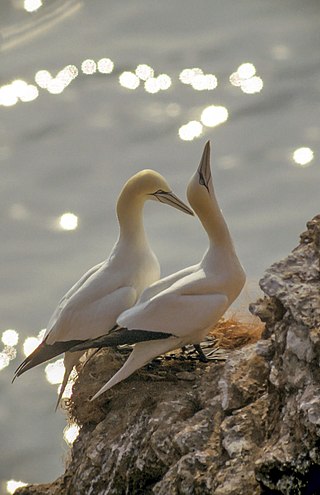
Hyenas, or hyaenas, are feliform carnivoran mammals belonging to the family Hyaenidae. With just four extant species, it is the fifth-smallest family in the Carnivora and one of the smallest in the class Mammalia. Despite their low diversity, hyenas are unique and vital components of most African ecosystems.
The Miocene is the first geological epoch of the Neogene Period and extends from about 23.03 to 5.333 million years ago (Ma). The Miocene was named by Scottish geologist Charles Lyell; the name comes from the Greek words μείων and καινός and means "less recent" because it has 18% fewer modern marine invertebrates than the Pliocene has. The Miocene is preceded by the Oligocene and is followed by the Pliocene.

The Anatidae are the biological family of water birds that includes ducks, geese, and swans. The family has a cosmopolitan distribution, occurring on all the world's continents except Antarctica. These birds are adapted for swimming, floating on the water surface, and in some cases diving in at least shallow water. The family contains around 174 species in 43 genera.

Rails are a large, cosmopolitan family of small- to medium-sized terrestrial and/or semi-amphibious birds. The family exhibits considerable diversity in its forms, and includes such ubiquitous species as the crakes, coots, and gallinule; other rail species are extremely rare or endangered. Many are associated with wetland habitats, some being semi-aquatic like waterfowl, but many more are wading birds or shorebirds. The ideal rail habitats are marsh areas, including rice paddies, and flooded fields or open forest. They are especially fond of dense vegetation for nesting. The rail family is found in every terrestrial habitat with the exception of dry desert, polar or freezing regions, and alpine areas. Members of Rallidae occur on every continent except Antarctica. Numerous unique island species are known.

Gannets are seabirds comprising the genus Morus in the family Sulidae, closely related to boobies.

Tringa is a genus of waders, containing the shanks and tattlers. The genus name Tringa is the Neo-Latin name given to the green sandpiper by the Italian naturalist Ulisse Aldrovandi in 1599. They are mainly freshwater birds, often with brightly coloured legs as reflected in the English names of six species, as well as the specific names of two of these and the green sandpiper. They are typically associated with northern hemisphere temperate regions for breeding. Some of this group—notably the green sandpiper—nest in trees, using the old nests of other birds, usually thrushes.

Anas is a genus of dabbling ducks. It includes the pintails, most teals, and the mallard and its close relatives. It formerly included additional species but following the publication of a molecular phylogenetic study in 2009 the genus was split into four separate genera. The genus now contains 31 living species. The name Anas is the Latin for "duck".

Chrysemys is a genus of turtles in the family Emydidae. They are found throughout most of North America.

Gomphotherium is an extinct genus of gomphothere proboscidean from the Neogene of Eurasia, Africa and North America. The genus is probably paraphyletic.

Guloninae is a subfamily of the mammal family Mustelidae distributed across Eurasia and the Americas. It includes martens and the fisher, tayra and wolverine. These genera were formerly included within a paraphyletic definition of the mustelid subfamily Mustelinae.
The Late Miocene is a sub-epoch of the Miocene Epoch made up of two stages. The Tortonian and Messinian stages comprise the Late Miocene sub-epoch, which lasted from 11.63 Ma to 5.333 Ma.
The Middle Miocene is a sub-epoch of the Miocene Epoch made up of two stages: the Langhian and Serravallian stages. The Middle Miocene is preceded by the Early Miocene.
The Early Miocene is a sub-epoch of the Miocene Epoch made up of two stages: the Aquitanian and Burdigalian stages.

Urotrichus is a genus of talpid that contains a single living species, the Japanese shrew mole (Urotrichus talpoides). Two fossil species are also known.

Nakalipithecus nakayamai is an extinct species of great ape from Nakali, Kenya, from about 9.9–9.8 million years ago during the Late Miocene. It is known from a right jawbone with 3 molars and from 11 isolated teeth, and the specimen is presumed female as the teeth are similar in size to those of female gorillas and orangutans. Compared to other great apes, the canines are short, the enamel is thin, and the molars are flatter. Nakalipithecus seems to have inhabited a sclerophyllous woodland environment.
Syllomus is an extinct genus of sea turtle from the Miocene-age deposits in the US Eastern Seaboard and Egypt.

A gazelle is one of many antelope species in the genus Gazella. This article also deals with the seven species included in two further genera, Eudorcas and Nanger, which were formerly considered subgenera of Gazella. A third former subgenus, Procapra, includes three living species of Asian gazelles.

Hemicyoninae is an extinct subfamily of Ursidae, often called dog bears. They were bear-like carnivorans living in Europe, North America, Africa and Asia during the Oligocene through Miocene epochs 33.9–5.3 Ma, existing for approximately 28.6 million years. They are sometimes classified as a separate family.
The Macropodidae are an extant family of marsupial with the distinction of the ability to move bipedally on the hind legs, sometimes by jumping, as well as quadrupedally. They are herbivores, but some fossil genera like Ekaltadeta are hypothesised to have been carnivores. The taxonomic affiliations within the family and with other groups of marsupials is still in flux.












